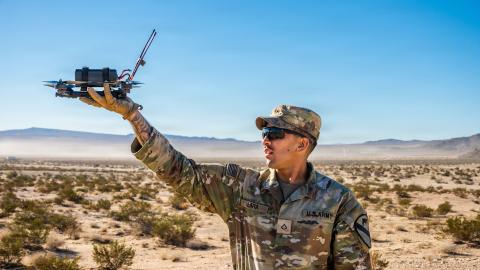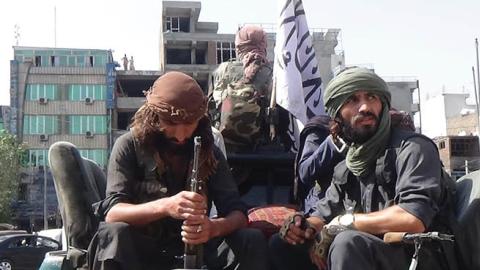As the third-ranking official at the us agency for international development (USAID) During the George W. Bush administration, I flew to Singapore on Sept 11, 2001. I found travellers huddled under television monitors at Changi airport, staring up at images of the world trade center being struck by commercial aircraft and collapsing.
Across the Pacific Ocean, I deeply felt the fear and anger of my family, colleagues and fellow Americans. Violent attacks on innocent civilians in our homeland would demand a harsh response. The next day, then President George W. Bush declared a war on terror. The Taliban’s resolve to harbor the al-Qaeda terrorists responsible for the attacks meant that America would soon be at war in Afghanistan.
Now America’s war in Afghanistan is concluding with the Taliban’s leaders back in control in Kabul, 20 years after they were removed by the U.S. military. The Taliban’s endurance can be attributed to many factors. But its rapid resurgence is the result of President Joe Biden’s withdrawal of us military forces. As George Orwell said: “the quickest way of ending a war is to lose it.”
here in Washington, Mr. Biden is under fire, blamed for a calamitous retreat of power reminiscent of helicopters evacuating the Saigon embassy in 1975. Some think the Taliban could have been held at bay indefinitely - provided us troops stayed. Others argue that America’s war in Afghanistan had to end but that Mr. Biden has mishandled failure. Afghans decry American abandonment. Allies and partners around the world are understandably alarmed and asking about the durability of us security guarantees.
When anger and fear dominate, sober decision-making becomes fraught. However, Mr. Biden did not make the call to bring home American troops lightly. Afghans had 20 years to develop capacity and legitimacy. Twenty more years of costly and sometimes deadly military deployment would not necessarily alter the prospects. The Taliban was deterred by us military presence, not Afghan security forces.
Afghanistan’s relapse into state failure suggests at least three stark lessons for America’s allies and partners in the Indo-Pacific region: Projecting power into another’s territory is subject to severe limitations; Coping with emerging challenges requires making strategic trade-offs; And shifts in the security landscape - such as the fall of the us-backed Afghan government - will escalate demands on the United States to reassures friends and deter potential foes.
The Limits of Power Projection
Plans founded on illusions can turn dreams into nightmares. Thus, from strategy to military power projection to advancing development, policy ambitions must hew closely to reality.
A strategy must promote realistic goals that match available resources. While Mr. Biden incurs a torrent of political blame, the onus primarily belongs on previous us administrations of both parties which failed to reconcile expansive ends with limited means. Unbridled aspirations fed grandeurs of state-building in a place hostile to good governance.
The fiasco was not trying to help Afghans but in overreaching in our estimation of what could be done from the outside. Far worse than America’s ambitions in Afghanistan was our rapid loss of strategic focus by intervening in Iraq, an actor not responsible for the tragedy of Sept 11.
Many contended that too much was invested to cut and run, a mindset that produced America’s “forever war”. But Mr. Biden made a tough call, however poorly executed, understanding that buying time was neither a strategy for victory nor a sufficient rationale for risking more lives.
If a successful strategy must align ends and means, the ability to project power is only as strong as local conditions allow. The potency of offensive force must not be measured by its lethality or technological sophistication alone. Instead, it also needs to be assessed based on its impact on the society in which troops are used and how they can help achieve desired objectives. In short, projecting power from afar cannot impose order on the ground without sufficient political will and support from the local population. Nowhere is this truer than in Afghanistan, the graveyard of empires.
In 2009, when I was directing the Institute for National Strategic Studies at the National Defense University, my Chinese people’s liberation army (PLA) Counterpart privately advised me that the United States would be wise to withdraw its military forces from Afghanistan. In hindsight, his admonition appears prescient. America and its coalition could not endlessly fund or compensate for the dearth of organic political will and fighting capacity inside Afghanistan.
Despite the horror of watching the Taliban take charge as the United States retreats, America’s allies and partners may at least appreciate the apparent advantages accompanying the defense of one’s territory. Japan, Singapore, the Philippines, Vietnam, Australia, India, and others can benefit from studying the asymmetric advantages of protecting one’s territory and making a country impregnable.
There is already momentum behind helping Indo-Pacific militaries achieve better anti-access and area-denial (An a2/Ad approach often used to describe many PLA defenses). As precision, long-range conventional strike capabilities become more accessible, even the most advanced militaries must acknowledge the heightened risk of action.
But what the Taliban shows, in its variant of people’s war, is how the greatest defense resides in the population. To be sure, America’s more enlightened allies and partners are unlikely to want to replicate Afghanistan’s disunity and sheer ungovernability to achieve the ultimate porcupine defense. Nonetheless, policymakers in Taiwan, for instance, might well refine their overall defense concept to further gird for protracted civil defense as one more layer of indigestibility that Beijing would have to consider before ever annexing it by force. A channel of water some 160km wide may not seem distant, yet the governments and peoples on either side of the Taiwan strait could not be more different on issues of individual liberty.
Because projecting offensive military power can fail to achieve desired political objectives, sometimes with disastrous consequences, states are naturally reluctant to occupy contested territory. A silver lining on the dark cloud hovering over America’s war in Afghanistan is recognizing that power imposed from afar ultimately fails.
The Necessity of Strategic Trade-Offs
disciplined strategists and policymakers understand that all resources are finite. Sometimes it is necessary to slough off important but lesser concerns to protect vital interests better.
Striking al-Qaeda was a counter-terrorism success. Striving to make Afghanistan into the American image was an exercise in futility. As former undersecretary of defense Michele Flournoy reflects: “in retrospect, the United States and its allies got it really wrong from the very beginning. The bar was set based on our democratic ideals, not on what was sustainable or workable in an Afghan context.”
it was also an expensive endeavor. According to the us special inspector-general for Afghanistan, America has spent some US$83 billion (S$113 billion) Over the past 20 years equipping and training the Afghan national defense and security forces. Yet, when the Taliban lurched forth, those forces appeared to melt away. Us troop presence had greatly amplified the perception of a capable Afghan security force.
There is no victory without sacrifice, and no cost-free engagement, no technological silver bullet, no capacity building without paying the price. But allies and partners must be more intelligent about their defensive strategies, and Americans must be more discerning about their investments. Funding the right goals will be essential. Fortunately, the Biden administration is committed to close regional engagement, greater capacity building and comprehensive bilateral and multilateral diplomacy.
Fiscal realities have an obvious bearing on inter-state competition elements, from high-technology research and development to military modernization and force posture. If the United States requires urgent spending to address a pandemic and long-neglected infrastructure needs, then it will have to raise revenue or cut other spending or both.
Some trade-offs involve more than sound fiscal policy. Sometimes, strategic priorities must change. For example, maritime power is critical to longstanding us strategy. Yet, the us navy has maintained its global presence and high operational tempo with about half the force structure it had just over three decades earlier. In the meantime, the PLA navy has multiplied and modernized, moving in tandem with other Chinese military forces from a largely anti-access force to a power-projection force. The United States may not avoid making strategic trade-offs across the spending level of future defense forces.
However, what is clear is that the Biden administration is making a deliberate strategic trade-off regarding global priorities, aiming to lighten its burdens in south-west Asia to concentrate on its more extensive interests across the Indo-Pacific region. Top us advisers rightly judge the competition with China to be far more consequential than the risk from Afghanistan’s state failure.
Washington aims to free itself up for the major-power competition with an assertive and authoritarian China by divesting America of obligations from an unwinnable war in Afghanistan. Indeed, after the fall of Afghanistan, China will find itself having to shift even more significant resources to secure its western flank. The Biden administration’s strategic decision on Afghanistan represents a genuine “pivot” to Asia, not just the one articulated as a strategic direction during the Obama administration.
Recalibrating Reassurance and Deterrence
Finally, the Indo-Pacific region cannot help but probe, exploit and adapt to the jarring events in Afghanistan.
Whatever the Biden administration’s strategic design, and regardless of concerted efforts to rally the like-minded around upholding a rules-based order, allies and competitors alike will wish to test the proposition that American power is diminished, and that Washington can’t fulfil its commitments.
The Biden administration should expect its credibility to be tested early and often. Friends will ask new questions about America’s dependability. Adversaries may make blandishments about trust-building, but they are sure to press Washington over its current appetite for danger.
For Asia, the sudden turn of fortunes in south-west Asia will compel anxiety and ambition. How one interprets the impact of unfolding events now becomes a factor, perhaps an impediment, in shaping a free and open Indo-Pacific region.
As Asian governments assess their conclusions from the sudden turn of fortunes in Afghanistan, this much seems certain: There is no substitute for forward, physical presence. In the Indo-Pacific region, concrete demonstrations of reassurance and deterrence from the United States are sure to be in high demand. The Biden administration must be present and ready.
America’s pullout from Afghanistan and the spectre of a Taliban-run regime in Kabul make it harder for Mr. Biden to claim that “America is back”. Illiberal powers will have an easier time peddling their sharp-power narratives to the effect that the United States is a declining power. But not all is lost eight months into an administration wedded to working with allies, investing in foundational strength, committed to building institutions at home and abroad, and shedding some commitments not vital to the long-term competition in the Indo-Pacific region.
Afghanistan’s throwback to the Middle Ages is a tragedy for many Afghans and a sad day for Americans. But it is not a requiem for America or democracy. Indeed, while the finger-pointing will be unrelenting - as if the assignation of blame absolves us from our collective dilemmas - the pullout decision was based on a cooler calculation of costs and benefits. We should strive for a better world, and we have a moral obligation to try to help the vulnerable. But no country can afford to squander its finite resources on a succession of losing causes that, in turn, undermine the ability to safeguard one’s citizens and assist others.
By better understanding the limits of power, making complex strategic trade-offs, and working with allies and partners to preserve the peace and deter coercion and malign behavior, a growing set of prosperous governments can strengthen their bonds of cooperation to ward off the most salient emerging threats that could sink a free and open Indo-Pacific. But no one should underestimate the time and effort that will be required for success.
Read in The Straits Times














